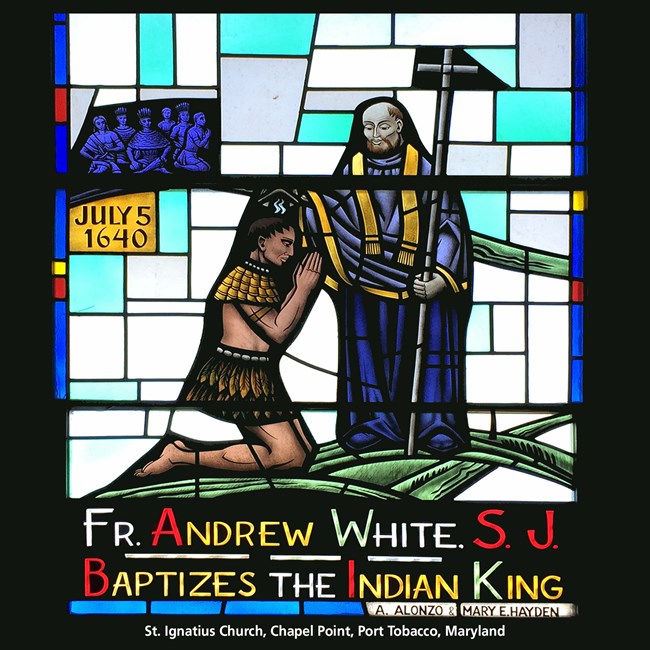Last updated: August 27, 2021
Article
From Potapaco to Port Tobacco

NPS, Thomas Stone National Historic Site
According to Smith's detailed journal entries, on July 8, 1608, Smith left the Potomac River and went about four miles up the Port Tobacco River into what is now Charles County, Maryland. He soon encountered an Native American village, which he listed as “Potapaco," a village of around 130 people. Smith’s visit was a peaceful one, however, the Potapaco probably did not comprehend how European claims to the Chesapeake region would change their lives over the next few decades.
In 1632, King Charles I of England granted a charter for the Province of Maryland to Charles Calvert, Lord Baltimore, as a haven for Catholics who were persecuted by other Christians in Europe. Although Charles Calvert died soon after, the charter remained and Calvert's sons, Leonard and Cecilius (Cecil) would assume the governorship of the colony.
By 1640, Father Andrew White of the Society of Jesus (the Jesuits) took up residence among the Potapaco tribe. Within a decade, Father White was developing the Catholic run plantation known as St. Thomas Manor, located at the intersection of the Port Tobacco and Potomac Rivers attached to today's St. Ignatius Church. Father White sought to learn and understand the Potapaco during his stay in Maryland. He even composed a catechism in the Potapaco dialect and compiled a dictionary and grammar guide of the language.
The natural resources, the strategic position, and farming potential, quickly led Europeans of all religious demominations, including Catholics, Anglicans, and Puritans to settle in the area. However, in 1642, war broke out in England between supporters of King Charles I and the Protestant Parliament. The conflict spread to the colony of Maryland. In 1644, Puritans ordered an attack on Father White’s small community of Catholics at Potapaco and he was brought back to England in chains.
In response to the religious tensions in Southern Maryland, Lord Baltimore appointed William Stone as the Proprietary Governor of the Provence of Maryland, the first Protestant to hold that position. Together, they signed the Religious Toleration Act of 1649, declaring that all practicing trinitarian Christians, Catholic or otherwise, had equal rights in Maryland. Many, particularly the Puritan faction in Maryland, resisted the Act.
In late-1654, a force of Puritans removed William Stone from his position as governor. Lord Baltimore ordered Stone to raise an army to confront the Puritans and regain his governorship. On March 25, 1655, the twenty-first anniversary of the founding of the colony, Stone's forces fought against the Puritans in the Battle of the Severn, near the site of modern-day Annapolis. Stone's forces were defeated and he was captured and held prisoner for almost three years. After his release in 1658, Lord Baltimore rewarded Stone by giving him as much land near the Port Tobacco River as he could travel on a horse in one day. Stone claimed a nearly 5000-acre site, which he named Poynton Manor, and this property established the Stone family in Charles County which had been created the same year as Stone's release.
By the end of the century, the number of Native Americans in the Port Tobacco area, which once had numbered in the thousands, had severely diminished through death and forced relocation. This change opened a new era of settlement and growth in Charles County.
The Town of Port Tobacco was formally established as the governmental seat of Charles County by the Maryland Acts of Assembly in 1727. Though occasionally referred to as Chandler’s Town and Charles Town, most called it Port Tobacco, a variant of the “Potapaco” name.
Soon a prosperous town developed with taverns, artisan shops, and a jail. Beside the “Public Square” stood early incarnations of Christ Church and the Charles County Courthouse. Nearby was a pillory, a structure designed to secure a person’s head and hands during public punishment.
One of the busier ports in Maryland, Port Tobacco traded with markets around the world. Locally grown corn, tobacco and other agricultural goods were transported by ox carts or even rolled in wooden barrels down the nearby hillside to Warehouse Point and shipped overseas. European goods, Caribbean sugar, silks, tea, and china were bartered for along the waterfront and the various merchant shops. Enslaved Africans were imported for the purchase in Port Tobacco and held in bondage as laborers and property in the surrounding community. By 1750, roughly 40% of Maryland's population of 130,000 were enslaved.
By the time the American Revolution was won in 1783, Port Tobacco was in decline. Clearcutting of nearby farmland and the removal of topsoil led to siltation in the Port Tobacco River. This turned what was once one of the best natural ports in the region to a marsh. In addition, competing ports, like Baltimore, grew much faster than Port Tobacco.
In the 19th century, the Civil War saw Port Tobacco gain a notoriety as Federal troops searched for the assassin of President Abraham Lincoln. The troops did not have any kind things to say about the town or its population, with one soldier referring to the "...dilapadated town and people thereof." The arrival of the railroad at LaPlata in 1888 and the move of the county seat there in 1895 signaled the end of Port Tobacco's importance.
Today, the Town of Port Tobacco is the smallest incorporated town in Maryland. The navigable section of Port Tobacco River has receded over a mile from the town. Yet, hints of its former greatness still exist as several historic structures survive including St. Ignatius Church, located on the same lands that Father Andrew White established as a Catholic community among the Potapacos.
